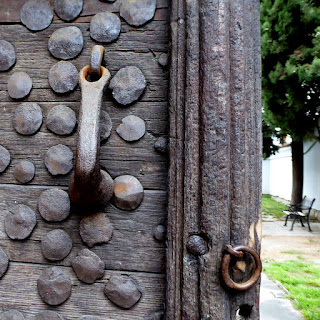Why visit Plovdiv? That's "PLOFV-difv", by the way. It is going to be European City of Culture in 2019, so you should think seriously about this question. A word that sums up the city is the commonly heard local expression 'Aylac' meaning easy-going. It's small place, easy to get around, and charming. The city's motto, Ancient and Eternal, is very cool too.
Plovdiv is the second city in Bulgaria and the oldest continuous city site in Europe. It has been settled since 4000 BC and just up the hill from the best place to stay, the Old Plovdiv Guest House (a boutique hostel no less - I am selective), you can walk around the hilltop ruins of a prehistoric fortress. In roman times the city used to be called Philippopolis, and it was an important trading centre on the Via Metropolis, the main road that linked east to west. The patron saint is St Erasmus, who was the bishop of Philippopolis. I guess that was way back in the 1st century, because after that the town was run first by the Romans, and later by the Turks for 500 years.
Iron nails in the gate of the caravanserai known as Kurshum Inn, a landmark in medieval times. Fifty horses at a time could drink from the fountains in the courtyard.
An enormous Roman amphitheatre that seated over 30,000 people has been discovered under the main street. It remains only partially excavated but you can sit in a modern cafe overlooking a part of it.
The building below is now the Ethnographic Museum. It was built in 1847 during the Bulgarian renaissance, in the baroque style. As Turkish power declined, local culture again began to flourish, and wealthy people began building in European style drawing on traditional arts and crafts. Many grand houses like this are now small museums so you can look around and enjoy the architecture.
 Traditional folk costumes are on display at this one, demonstrating some fine examples of the bulgarian style of knitting that has also had a bit of a renaissance. Just check on Ravelry.
Traditional folk costumes are on display at this one, demonstrating some fine examples of the bulgarian style of knitting that has also had a bit of a renaissance. Just check on Ravelry. I loved the timber ceilings which are ornately carved and completely different in each room.
Now here's just a pile of 2nd century rubbish. Bits left over when the roman amphitheatre was being restored, having been buried for thousands of years and only rediscovered 50 years ago, are now used by students from the music conservatorium as a place to sit and have a smoke or a coffee.
Underneath the Old Plovdiv Guest House some remains of 2nd century walls have been exposed, and there they were at the end of the breakfast room. So I sat with the Romans to eat my boiled egg.
There are two walking tours each day. The main city tour in the afternoon was led by Kathy. She and Nick are both 19 year-old law students. In the morning Nick (no that's not Nick) led a walk around the special area known as The Trap. A warren of narrow streets that used to be the bazaar until it burned down, it is now full of bars and graffiti and arty little shops - in fact if you are looking for an opportunity, you can have free rent for a year in one of the shops as long as you are doing something creative. Worth considering. I had an artisan coffee in a little place where the beans are roasted on the premises for a cost of around 60 cents.
Don't drive into the Trap - it is a maze and there's only one way out, this one.
The main streets are walking streets - so civilised. And there are some lovely parks.
Just another bit of graffiti.
So if you are headed for Bulgaria, don't miss Plovdiv.
Even the ruins are charming.














No comments:
Post a Comment